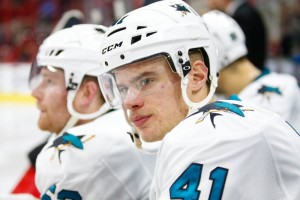On December 25, last year the San Jose Sharks were 17-15-2 for 36 points. Through the same number of games, the Sharks are 21-12-1 (43 points) at the 2016 Christmas break. What are the reasons for the improvement?
It Is Not the Offense
The most obvious statistical change in the Sharks’ performance this season is that their scoring is down from 2.89 goals per game to 2.48 goals per game.
The 2016-17 Sharks are 22nd in the league in scoring as opposed to their 4th best scoring average last season. The drop is not a result of the number of shots the team gets on net each game. San Jose is averaging the same 30 shots per game they did last season. In fact, the Sharks have not scored five goals in any game this season.

The power play is the reason for the Sharks’ drop in scoring. Last season the Sharks were third in the league at 22.5% and this year they sit 19th at 17%. The power play production, or lack of production, is the most significant statistical decrease for the Sharks’ offense year over year.
The power(less) play performance is directly related to the failure of the Sharks’ second power play unit. The first unit of Brent Burns, Logan Couture, Joe Thornton, Joe Pavelski, and Patrick Marleau has accounted for 14 of the Sharks’ 18 goals with the man advantage, and this is even with the fact that Thornton has not scored a power-play goal this season.
The return of Tomas Hertl later this season will certainly help the second power play unit. But Hertl alone is not enough as the unit was not scoring when he was in the lineup. Acquiring power play help for the second unit, most needed on the back-end, is needed. A quarterback to run the unit from the blue line is desperately needed. Marc-Edouard Vlasic has never been the answer and David Schlemko has proven ineffective as well this season. If Mirco Mueller is not the answer, then outside help is going to be needed.
Is It the Defense?

While there is a 14% decrease in scoring, it is almost completely offset by the 12% drop in goals allowed, 2.52 to this season’s 2.21. Just as the shots taken by the Sharks has not changed, the number of shots allowed has not changed much at all, 27.4 last season to 26.2 this year.
An improved penalty kill sets the tone for the decrease in goals allowed this season. During 2015-16 the Sharks ranked 21st in penalty kill percentage at 80.5%. This season the team has been more effective as they sit 9th at 83.5 percent having allowed only 15 goals in 91 shorthanded situations. As with any penalty kill, the Sharks best penalty killer has been their goalie, Martin Jones.
While a 3% change does not seem like a significant change, the tight checking low-scoring style that the team plays results in close game after close game. Every goal not allowed is significant.
Maintaining the penalty kill will be easier than improving the power play as the Sharks have great depth in this area. Almost every player in the lineup has contributed to the success of the penalty kill. Using this depth may be the best way to find power play assistance.